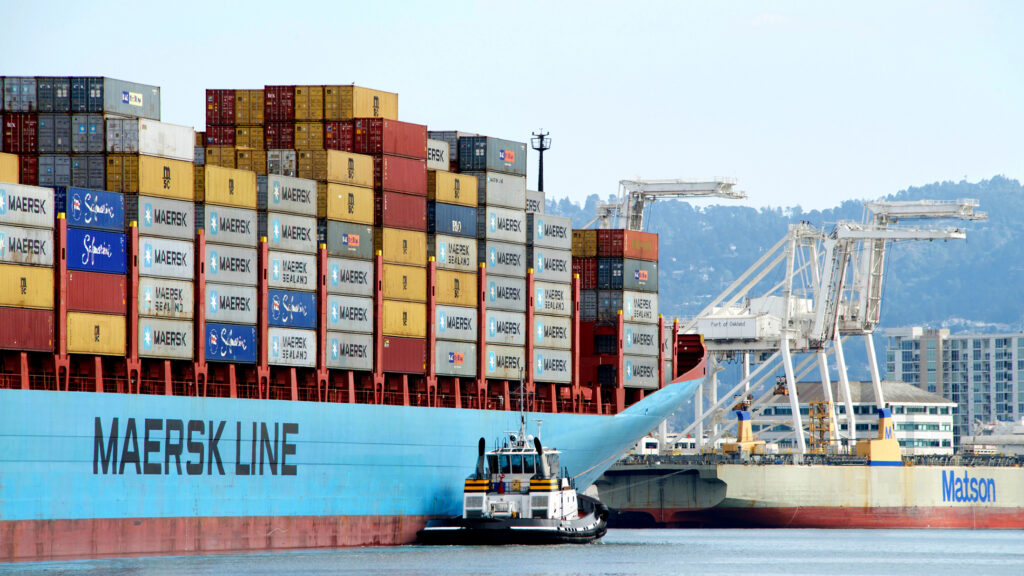Mixed expectations for cargo shipping in 2017
By Mike Jarrett
2017, March 1: The year just ended was one that many who move cargo would like to quickly forget.
Hanjin Shipping going into receivership after banks withdrew backing then subsequently filing for bankruptcy on August 31 was a shocker. At one time the world’s seventh largest line (by capacity) and fourth in the US market was on its back, weighed down by debt. Its mid-year report indicated total debts of USD5.5 million and the banks did not think its financing plans were sufficient.
Its Asia offices stopped taking bookings. Its ships were being arrested in terminals where they were docked at the time the crisis hit the news. Ports turned down berthing requests in fear they would not have been able to collect fees. South Korea’s largest shipping line had all of its assets frozen; cargo-loaded ships idled for weeks; containers left sitting on docks all over the world; and, creditors seizing its assets for outstanding debts. It was a mess that could not be cleaned up by $54 million approved by the Hanjin Group (to recover billions of dollars of stranded cargo in half-million containers in ports and elsewhere).
Up for sale
Then came rumours about another major global carrier, Hamburg Süd, now the seventh largest global line by capacity. The German giant was said to be up for sale. By the end of November, the Wall Street Journal reported the rumours. And within a week, A.P. Moller-Maersk announced that Maersk Line, already the world’s biggest shipping company, would be acquiring Hamburg Süd.
Maersk has more than 600 ships. Hamburg Süd operates about 130 vessels in its largely north-south traffic. The acquisition reduced the average age of Maersk’s fleet, now 741 container ships, from 9.2 years to 8.7 years. The acquisition was also expected to increase Maersk’s influence and presence in Latin America, where Hamburg Süd has had a high profile for almost 150 years.
“This will provide us with a very strong platform in Latin America,” said Søren Skou, CEO of Maersk Line since 2012; and, recently (June 2016) appointed Maersk Group CEO. He had CEO of the Transport and Logistics division added to his portfolio in October 2016.
 Maersk shares immediately shot up 5% as its new acquisition boosted its market-share by more than three percentage points to 18.6%. This is Maersk’s first acquisition since it took over P&O Nedlloyd in the summer of 2005.
Maersk shares immediately shot up 5% as its new acquisition boosted its market-share by more than three percentage points to 18.6%. This is Maersk’s first acquisition since it took over P&O Nedlloyd in the summer of 2005.
Even before the rumours about Hanjin started circulating, CMA CGM had inked a deal in which it took control of Neptune Orient Lines (NOL). On June 10, the French group took control of the Singapore-based NOL, known for its APL brand, making it a subsidiary. CMA CGM then boasted in advertisements under the banner ‘Together Stronger’ that NOL, the number 12 in world container shipping, would make it stronger and give it: 11.7% of market share; a fleet of 536 vessels; and, capacity of 2.4 million teu. The acquisition was expected to give CMA CGM market leadership in the trans-Pacific trade.
And, in the last week of November, the European Commission gave conditional approval to a merger between Hapag-Lloyd and United Arab Shipping Company (UASC). The Business Combination Agreement merging the two companies was announced by UASC on July 18. The merger will rank Hapag-Lloyd among the five largest container lines in the world, with 237 ships and a fleet capacity of about 1.6 million teu.
The year ahead
Industry experts are not gung-ho about 2017. No one believes the world changed on December 31 at midnight. They are saying: “… more turmoil and volatility…”, “… outlook is still bleak …”; “… things will get worse before they get better.” Hardly encouraging prognostications. However, if M&A (mergers and acquisitions) was the theme for 2016, ‘consolidation and strategic alliances’ could well be the thrust in the year ahead.
The global market remains over supplied. And, unless scrap yards are worked to record levels in 2017 and steel prices increase, it is likely to remain so in the year ahead.
Global trade has not increased and indeed could slow if the new USA President’s stated policy of protectionism impacts US trade – imports and exports. Meanwhile, seeking economies of scale from an expanded Panama Canal, shipping lines continue to invest in new capacity. The global industry may therefore be hedging against falling freight rates by the end of the period.
This of course could stimulate trade. Indeed, Amazon and Alibaba may be depending on it.
Early in 2017, CMA CGM announced that it now allowed exporters in China to book container space on two of its routes using Alibaba’s ‘One Touch’ booking facility. Alibaba, the world’s largest e-commerce platform, has long offered foreign companies and consumers the ability to do business directly with manufacturers in China. However, container-load purchases had to be shipped out through a freight forwarder or carrier. With OneTouch, Chinese exporters can bypass the forwarder and arrange shipping directly through Alibaba.
It is understood that CMA CGM’s participation in OneTouch will be limited to container service to the Mediterranean and Adriatic area.
Israeli line Zim completed a similar deal with Alibaba in February 2017 and Maersk lines began offering services through OneTouch in December last.
OneTouch service was then available for exports from eight ports – Shanghai, Ningbo, Shenzhen, Dalian, Tianjin, Qingdao, Xiamen, Guangzhou – going to some 40 destinations worldwide including Canada but not the USA.
Caribbean perspectives
Maritime experts in the Caribbean-Latin American region did not seem particularly perturbed about what 2017 had to offer. The perspectives gained from the various responses represented a mixed bag. It was felt that the results of the strategic mergers and partnerships implemented had not yet delivered results and that these could bring positive results.
Notably, there was no consensus around doom and gloom. Rather, there was an attitude of hope and positive expectation. Globally, ports that depend on revenues from cargo movement across its yards may have good reason to be cautious about the year ahead, having seen the drama that 2016 presented. However, in the Caribbean region, there is no abiding concern about 2017.
RAWLE BADDALOO, maritime consultant; Past President of the Caribbean Shipping Association:

This year, 2017 is likely to be another bad year in regional shipping.
Why?
- In Trinidad and Tobago, for example, because of the oil and gas crisis the purchasing power is gone. Getting foreign exchange is very difficult so shipping volumes are down. There is also a glut of ships. Some 200 old Panamax-size vessels need to be scrapped if rates are to go up.
- With the Trump Administration and strengthening of the Jones Act and American Protectionist policies it is a new ball game.
- It will be some years before Oil and Gas improves in Trinidad and Tobago. Depending how Guyana moves forward Trinidad and Tobago may gain some benefits.
- On the commodity side where Trinidad and Tobago is normally strong there is no feed stock (gas) so many plants have shut down or running at less than half capacity. There is not enough action on alternate energy and diversification.
- Jamaica though is set for interesting times as they seek recognition from IMO as a maritime hub. There are also plans to put in dry docks, something the region sorely needs.
I think it will be around 2020 before we see any positive growth, real growth not paper growth which Economists love. ______________

GIOVANNI BENEDETTI, Chief Commercial Officer, SPRC, Cartagena, Colombia:
Looks like year 2017 is going to be positive for us, we expect 8% to 12% volume increase over 2016.
Why?
- Better performance of the Colombian economy, imports and exports growing;
- Additional volume is being generated because of the fleet changes taking place;
- Hapag reorganizing its network via Cartagena as a hub; and,
- Other carriers entering the market and transshipping new, smaller volumes.______________

CARLOS URRIOLA, President SSA International; Past President of the Caribbean Shipping Association:
My expectations for 2017, given the realities of global shipping in 2016, are neutral.
Why?
Shipping lines are consolidating and new terminals are starting operations or completing construction.
Observations or concerns?
We must adapt. Innovation is the word of the 2017 and going forward. BCO is booking cargo using Alibaba. Amazon is becoming a big logistic operator. Shipping lines are owning terminals in Latin America and the Caribbean. We must be flexible, like the bamboo, bending with the wind but never breaking. ______________

JAN SIERHUIS, Director Maritime Authority of Curaçao:
For shipping in general, 2017 may be slightly better in some sectors but overall not much change as against 2016.
Why?
Container sector will see some improvements in rates due to capacity decrease and consolidation. Liquid and dry bulk sectors are still in overcapacity, putting pressure on rates. The cruise sector will do well due to economic recovery of USA and European markets
Overcapacity remains in some sectors. The need for consolidation may shake up some markets.
Observations or concerns?
- Continued consolidation in the container sector will put transshipment rates in the Caribbean under pressure;
- oil prices vulnerable to uncertain political developments; and
- failure of Venezuela an issue for those trading Venezuelan oil. []





